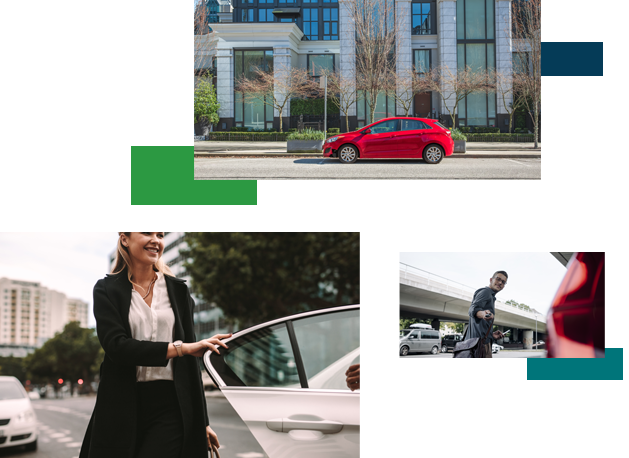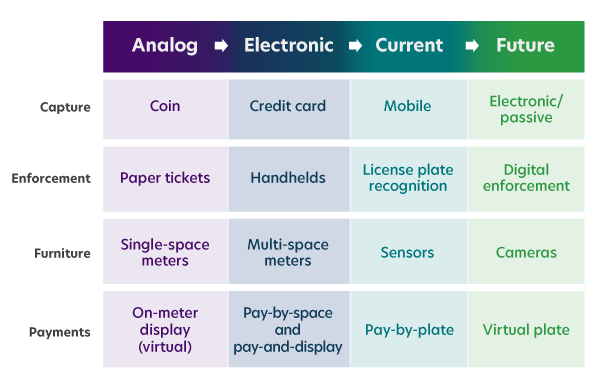The Future of On-Street Parking

For nearly a century, the fundamentals of paying for a parking session and issuing tickets remained unchanged, relying on coin meters and paper tickets. While this traditional approach worked adequately, it was always constrained by available tools and insights. Today’s technologies, however, allow for far superior platforms that can benefit parking authorities’ motorists, revenues, and smart city initiatives.
Through the Camera Eye – the Power of Automated, Always-On Image Capture
Camera-based enforcement technology has long been used for violation identification in the tolling, red light, and speed infraction arenas. With toll authorities largely transitioning from human-staffed tollbooths to gantry-mounted cameras and vehicle transponders that automate motorist invoicing, the results have been freer-flowing roads, improved revenue capture, and better motorist experiences.
The technology, however, is still relatively new in the parking management space. There are many operational use cases:
Meter spaces
Permit zones
Loading zones
Transportation network company (TNC) pickups/drop-offs
Lots
Ramps
Smart camera technology also enables authorities to manage parking assets with real-time precision that is impossible to achieve through traditional enforcement methods.
Bringing these principles to parking programs, smart cameras allow for a “meter-less parking” ecosystem, enabling motorists to pay for public parking spaces through prepaid accounts. Just as motorists can use toll roads without stopping to pay tolls, drivers can park in public spaces without feeding meters or paying by phone. Instead, strategically placed cameras automatically track parking sessions.
How it Works: Technology Meets Psychology
While the form factors and use cases for space coverage can vary, the fundamentals are the same: cameras begin capturing photos as soon as a vehicle enters a space, tagging the data with the date and with entry and exit times. The photos serve as the evidence from which license plate recognition (LPR) can then be performed. Using LPR software, authorities and their partners can precisely identify vehicles parked in designated spaces for specific durations.

Under the current, manual enforcement system, motorists experience a conundrum at the onset of each stay: “Should I pay the meter or risk a ticket?” It’s natural for motorists to weigh many options before making their decision, including:
Perceived likelihood of getting a ticket
The time it takes to pay a meter
The payment types accepted at the meter
The intended duration of their stay
Motorists who choose to pay may resent others who do not. Motorists who choose not to pay - and who receive a ticket - are likely to resent the fine and penalty.
With a digital ecosystem, motorists do not face this conundrum. Instead, they have a user experience that they can recognize as a more typical consumer transaction: “I need to pay for the service I use.” So the digital ecosystem creates a paradigm shift in consumer sentiment, moving from negative to positive.
Even with these advancements, some motorists will still choose not to pay, including habitual offenders. Agencies need to identify the vehicles of non-paying owners, so they can send notices and recover revenue. Therefore, the back office of any meter-less ecosystem must be able to determine vehicle ownership information for non-account holders, new users, and visitors.

Benefits
Autonomous enforcement platforms afford many benefits for agencies and motorists.
Benefits for agencies include:
In real time, determine if a car is parked in a space and provide occupancy information to the public
Identify which car is parked in a space, including any associated payment, permit, permission, and offender statuses
Maximize revenue – and compliance – through precise, rapid, and consistent invoicing
Optimize curbside management
Conduct virtual “meter-bagging”
Manage loading zones and TNC transactions
Make informed policy decisions based on robust, accurate data and analytics
Influence congestion and occupancy with dynamic pricing
Easily administer discount programs for designated groups (e.g., low-income residents, seniors, students, staff)
Lower operational and maintenance costs
Reduce auto exhaust emissions by streamlining on-street staff activities and minimizing the need for motorist circling and spot hunting
Remove meters, kiosks, and other cumbersome street furniture from high-traffic curb areas
Benefits for motorists include:
In real time, access space availability information and make reservations
Enjoy convenient, familiar, and mobile-friendly CX
Save time with “park and walk” experiences, rather than circling for spaces and fumbling with manual payments
Locate and use designated spots for disabled motorists more easily